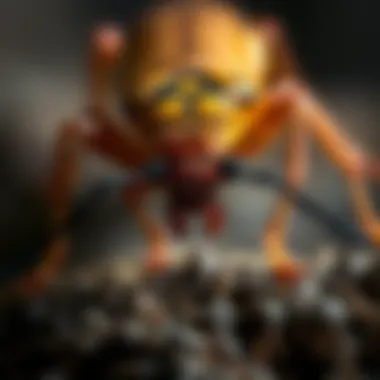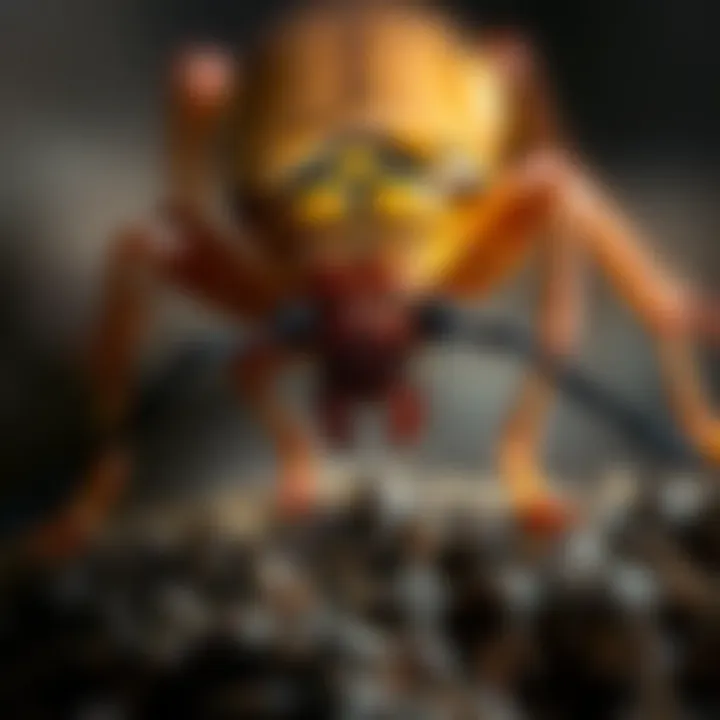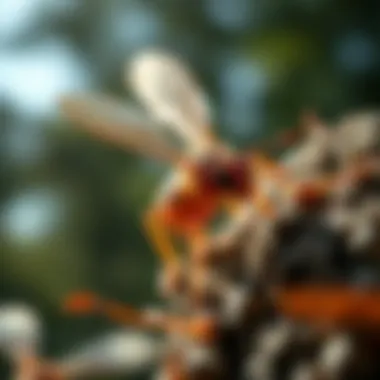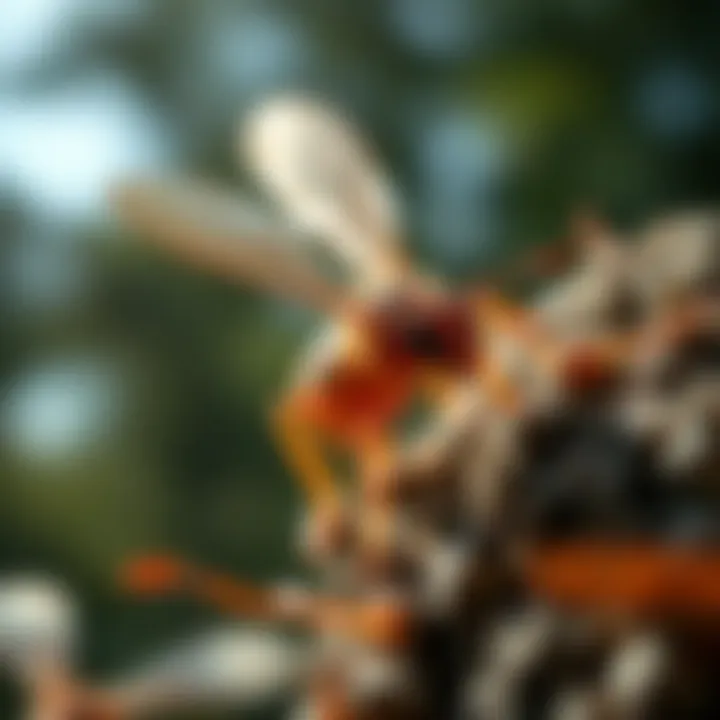Comprehensive Pest Control Strategies for Long Valley, NJ


Intro
In Long Valley, NJ, the charm of picturesque neighborhoods often gets overshadowed by pesky intruders—pests. As we all know, uninvited guests can wreak havoc not just on homes but also on gardens, making it essential to equip oneself with thorough knowledge about pest control. This article serves as a guide, focusing on the myriad strategies one could deploy in tackling pest issues specific to this region. We’ll delve into practices rooted in both conventional wisdom and environmentally sustainable methods, providing homeowners with effective tools to preserve their living spaces and greens.
Understanding Pests
Definition of Pests
Pests are organisms that cause damage or nuisance to fields, homes, and gardens, significantly interfering with everyday life. In Long Valley, one might typically encounter pests like the Eastern Boxelder Bug, deer ticks, and various forms of ants. Their presence can vary with seasons, and understanding this is crucial to managing them effectively.
Importance of Pest Identification
Identifying the specific pest invading your space allows for tailored control measures. Rather than employing a one-size-fits-all approach, homeowners should focus on understanding the lifecycle and habits of the pests they are dealing with. Take the time to observe their behaviors; this knowledge can lead to more effective and less disruptive solutions.
"An ounce of prevention is worth a pound of cure"—a sentiment that rings true in the world of pest control.
Prevention Techniques
Home and Garden Preventative Measures
Preventive action can often avert the need for drastic measures further down the line. Here are a few strategies:
- Regular Maintenance: Keep gutters clean and fix leaks that may attract pests seeking water.
- Seal Cracks: Inspect the exterior of your home for gaps and cracks, especially around windows and doors, and seal any openings.
- Proper Waste Management: Ensure garbage bins are tightly lidded to reduce attraction for rats and raccoons.
For gardens, employing barriers like row covers can protect young plants from insect larvae. This reinforces the idea that a proactive approach can significantly mitigate the risk of an infestation.
Seasonal Prevention Tips
Understanding seasonal variations aids in specifying when to implement preventive strategies.
- Spring: Begin inspections as the weather warms up, focusing on those pesky mosquitoes. Breeding can often be controlled by eliminating standing water where they breed.
- Summer: Regularly check for signs of carpenter ants and termites, especially after rain.
- Fall: Prepare for fall invaders like spiders and rodents looking for warm havens as temperatures drop.
- Winter: Seal entry points before the cold hits, as pests seek warmth inside homes.
Eco-Friendly Pest Control Solutions
Overview of Sustainable Practices
For the environmentally minded, pest control doesn’t have to mean chemical treatments. Sustainable practices such as introducing beneficial insects like ladybugs can naturally control aphid populations in your garden. Additionally, maintaining diversity in plant species can create a more welcoming habitat for helpful critters while deterring harmful ones.
Natural Remedies and Their Effectiveness
There are a variety of natural remedies that are not only effective but also safe for the environment:
- Diatomaceous Earth: This natural abrasive can control insects without the use of chemicals.
- Neem Oil: Extracted from the neem tree, this oil disrupts the life cycle of many pests when applied as a spray.
- Vinegar Solution: Mixing vinegar with water can repel ants and prevent them from invading your space.
Overall, employing these eco-friendly solutions provides peace of mind while still effectively managing pest populations. Embracing nature-friendly tactics can foster a healthier home and environment for all to enjoy.
For more detailed information, you can explore resources from Washington State University Extension at wsu.edu or visit the National Pesticide Information Retrieval System at npir.gov.
Foreword to Pest Control in Long Valley, NJ
Pest control is a vital component of maintaining a healthy environment in Long Valley, NJ. This region, rich in natural beauty, attracts a diverse range of pests that may pose threats to both homes and gardens. Understanding how to effectively manage these pests is More than just a convenience— it’s crucial for ensuring the safety and comfort of your living space.
Importance of Pest Control
Managing pests has several benefits, from protecting the structural integrity of homes to safeguarding health. Pests can lead to significant damage, such as rodents chewing through electrical wires or insects infiltrating wooden structures, leading to costly repairs. More than that, some pests, like ticks or mosquitoes, can carry diseases that affect families and pets alike.
One cannot underestimate the psychological burden that an infestation can bring. The sense of invasion and discomfort that comes with unwanted guests can disrupt daily life. Moreover, a pest-free environment raises the quality of living spaces, boosting the overall appeal of homes and gardens. For housewives and homeowners alike, understanding pest control strategies not only enhances the household but also assures peace of mind.
Considerations for Effective Pest Control
When considering pest control, it’s essential to take a comprehensive approach. One must understand the specific pest challenges unique to Long Valley. Not all methods work the same for different types of pests, and selecting the right approach—be it natural deterrents or chemical solutions—can make a significant difference.
Better yet, integrating preventative measures with active pest control strategies can lead to long-term results. This holistic view allows residents to preemptively address pest issues before they escalate into full-blown infestations, saving both time and expense. That's where a bit of insight into seasonal patterns can come in handy, as various pests show up during different times of the year.
Resources for Further Reading
For those desiring a deeper dive into pest control, several resources offer a wealth of knowledge:
- Wikipedia on Pest Control
- Environmental Protection Agency on Pest Management
- National Pest Management Association
In summary, understanding pest control in Long Valley, NJ, is not just a task but a necessity. Just like tending to a garden, it requires ongoing attention and adaptation. How one approaches pest management can protect their property and their loved ones, making it a topic that deserves careful consideration.
Understanding Local Pest Challenges


Understanding the local pest challenges in Long Valley, NJ, is key for anyone looking to manage these nuisances effectively. The region’s unique climate, geography, and urban development create an environment where certain pests thrive. By recognizing these challenges, homeowners can devise strategies to combat them effectively. Addressing these issues not only secures home environments but also protects flora and fauna in gardens.
Monitoring pests early can prevent small issues from becoming major headaches later. Moreover, comprehending pest behaviors—especially how they interact with their surroundings—can offer insights on effective control measures.
Common Pests in Long Valley
Homeowners must be familiar with the common pests that pose problems in Long Valley. This knowledge is essential in shaping pest control strategies.
Rodents
Rodents, particularly the Norway rat and the house mouse, are notorious in Long Valley. They are resourceful critters, often leading to significant infestations if not regulated. One standout characteristic of rodents is their ability to reproduce rapidly. A pair of mice can lead to a heaping population within months, making early detection crucial.
Their presence can be a catalyst for health concerns, as they can carry diseases and contaminate food sources. Ignoring rodent infestations can escalate into costly damage and extensive cleanup operations.
Insects
Insects such as termites, ants, and spiders are prevalent and pose distinct challenges too. Termites are particularly feared because they can quietly devour wooden structures, leading to structural damages before homeowners are even aware. Ants, on the other hand, display complex social behaviors and can quickly form colonies.
For instance, the carpenter ant can hollow out wood for nesting, causing unseen harms that weaken the integrity of homes. Understanding their life cycles and behaviors will help in planning pests management strategies as some pests are more active during specific seasons.
Wildlife
While they may be charming in nature, wildlife such as raccoons and squirrels can wreak havoc for homeowners. They often find ways to access attics or basements, where they create nests and cause chaos. One key characteristic of wildlife is their adaptability; they can thrive in both urban and rural areas, making them a persistent issue.
Though some may resist control measures, appreciating their ecological roles in pest control can lead to more humane management techniques. A balanced approach can protect homes while preserving the local ecosystem.
Seasonal Pest Patterns
The changing seasons in Long Valley brings about various pest patterns that homeowners should be aware of.
Spring Infestations
As temperatures warm in spring, activity ramps up for many pests. It marks the beginning of the breeding period for insects like mosquitoes and flies. These pests tend to emerge from their winter hideouts, expanding their territory quickly. For homeowners, recognizing these patterns can allow them to implement preventative measures. Methods such as landscaping adjustments and thorough cleaning can mitigate the influx of pests.
Summer Surges
Summer is often peak season for many pests, with high temperatures driving insects into living spaces. Particularly, the mosquito population swells, and they can become quite the nuisance for outdoor activities. This is the time to be proactive with preventive treatments. Regular yard maintenance can deter breeding, while repellent sprays can help keep mosquitoes at bay.
Fall Precautions
With the approach of fall, certain pests begin looking for winter shelter, often seeking it in homes. Preparing for this shift is crucial. Homeowners should seal entry points and ensure gardens are tidy to avoid attracting these late-season pests. Regular inspections during this time can prevent small incursions from turning into full-blown infestations as winter sets in.
"Understanding when and how pests occur can save homeowners from unnecessary headaches and costs while ensuring a healthier living environment."
By recognizing the challenges and seasonal patterns of pests in Long Valley, residents can better equip themselves with strategies to keep their homes pest-free. This proactive mindset is vital for effective pest management.
Preventative Pest Control Techniques
Preventative pest control techniques play a critical role in maintaining a pest-free home environment in Long Valley, NJ. These proactive measures help homeowners anticipate potential infestations before they escalate into serious problems. By implementing these techniques, individuals can save both time and money on pest treatments while preserving their peace of mind. A thoroughly prepared home not only shields against pests but also promotes a healthier living space.
Home Maintenance and Exclusion
Sealing Entry Points
Sealing entry points is fundamental in keeping pests out of the home. This method focuses on identifying and blocking areas where unwanted critters might sneak in. Common culprits include gaps around windows and doors, cracks in walls, or holes in the foundation. Filling these gaps with caulking or other materials acts like a sturdy wall, preventing entry.
A key characteristic of sealing entry points is that it is a cost-effective solution. Homeowners don’t need to break the bank on high-tech devices; simple materials can do the trick. This approach is particularly beneficial because it addresses the problem at its source—stopping pests before they even have the chance to cross the threshold.
However, while sealing entry points is advantageous, it does require diligence. The homeowner must regularly inspect these barriers, as wear and tear can create new vulnerabilities.
Proper Drainage
Proper drainage is essential for pest control as well. Standing water can attract a variety of pests such as mosquitoes, termites, and even rodents looking for a water source. Ensuring that gutters are regularly cleaned and directing water away from the house helps minimize risk.
The unique feature of proper drainage is its holistic impact; not only does it deter pests, but it also prevents water damage to the home's foundation. A well-drained landscape is less appealing to pests, making it a great preventative measure. While it may require initial effort to set up an effective drainage system, the long-term benefits far outweigh those costs.
Landscaping Considerations
Plant Selection
When it comes to landscaping, plant selection can significantly influence pest activity around a home. Some plants naturally repel pests, while others can attract them. For example, marigolds are known to deter nematodes and certain insects. Choosing native plants can also encourage beneficial insects that prey on pests.
The key characteristic of focusing on plant selection is its sustainable approach. Not only does it beautify outdoor spaces, but it also integrates ecological practices. This method fosters a natural balance, reducing reliance on chemical pest control methods. Still, the drawback is that homeowners should invest time in researching which plants thrive well in their specific environment, as choosing the wrong ones can inadvertently attract pests instead of repelling them.
Mulching Practices


Implementing proper mulching practices is equally important in pest prevention. Mulch helps retain moisture in the soil and suppresses weed growth, but it can also minimize the amount of bare soil that pests find inviting. With a variety of options available, such as hardwood or straw, homeowners can choose what's best suited for their gardening needs.
One of the unique features of mulching is its dual purpose; it serves as a decoration around plants while also serving as a pest barrier. However, mulching requires maintenance since decaying mulch can attract pests. It's crucial to monitor mulch for any signs of pest activity and replace it regularly as needed.
"An ounce of prevention is worth a pound of cure."
This quote rings especially true for pest control in Long Valley, NJ. By employing these preventative strategies, homeowners can build an effective defense against pests while contributing to a healthy ecosystem.
Eco-Friendly Pest Control Solutions
In today's world, where environmental concerns are ever-growing, opting for eco-friendly pest control solutions has become not just a preference but a necessity for many homeowners in Long Valley, NJ. These methods prioritize the health of both the ecosystem and those within it. They offer a sustainable approach that mitigates the harsh effects of chemical pesticides, ensuring a balance between maintaining a pest-free home and nurturing our environment.
The benefits of eco-friendly solutions are manifold. Firstly, these methods reduce the risks associated with chemical exposure, providing a safer environment for both people and pets. Secondly, they often involve practices that are just as effective – sometimes more so – than conventional techniques. A deeper understanding of some eco-friendly pest control methods can considerably help homeowners tailor their approach to fit their specific needs.
Natural Repellents
Natural repellents can be an excellent first line of defense against unwanted pests. Not only are they typically safer to use around kids and pets, but they can also be quite effective.
Essential Oils
Essential oils have garnered attention as potent natural repellents against various pests, including mosquitoes and ants. These oils, derived from plants, exhibit strong aromatic properties that deter insects effectively. A key characteristic of essential oils is their ability to mask scents that attract pests, rendering your home less appealing to them.
Using essential oils in pest control has gained traction due to their versatile applications. For instance, peppermint oil can be used to repel rodents, while tea tree oil can hinder insect infestations. However, it’s worth noting that while essential oils are generally safe, they should be used judiciously, as certain concentrations can be too potent and may cause irritation in sensitive individuals.
Advantages of essential oils include their accessibility and the pleasant scents they often impart. On the downside, the effectiveness can vary based on the pest and environmental conditions.
Herbal Sprays
Herbal sprays offer another layer of eco-friendly pest management. These sprays harness the natural properties of herbs to repel insects. For example, sprays made from herbs like basil and garlic can deter aphids and other garden pests while being non-toxic. The beauty of herbal sprays lies in their ease of preparation and use
Crafting herbal sprays is straightforward, involving simple methods of steeping herbs in water or vinegar. Their unique feature is the freshness they carry into the home environment, often enhancing it while driving pests away.
However, just like essential oils, herbal sprays may require frequent application due to their non-persistent qualities. They work best as a part of an integrated approach combining other pest management techniques as well.
Integrated Pest Management (IPM)
Integrated Pest Management (IPM) is a comprehensive strategy that emphasizes a long-term prevention approach while minimizing economic, health, and environmental risks. It integrates various pest control methods in a way that maximizes effectiveness while keeping negative impacts to a minimum.
Monitoring and Assessment
The foundational aspect of IPM is monitoring and assessment. By regularly checking for signs of pest activity, homeowners can catch infestations in their early stages. This proactive practice is vital as it informs the choice of intervention measures. Proper monitoring techniques include setting traps or conducting visual inspections, ensuring you stay ahead of any potential problems.
This approach is particularly beneficial in controlling populations before they spiral out of control. Regular assessments help an individual decide when to escalate their pest control measures efficiently. However, the initial time investment in monitoring can be a drawback for some homeowners, requiring diligence and dedication.
Targeted Interventions
Targeted interventions involve applying specific pest control measures aimed at particular pest problems identified through monitoring. This method is vital for reducing unnecessary applications of pesticides and making pest management resources more efficient. Using targeted interventions means applying treatments only when necessary and only in the affected areas.
The advantage of targeted interventions lies in their efficiency; they not only conservatively use products but also reduce the chance of pests developing resistance. Nevertheless, homeowners must be well-informed about the types of pests present and the most effective responses, which may require additional research and learning.
To wrap up, eco-friendly pest control solutions encompass a variety of methods, from natural repellents to integrated pest management strategies. Homeowners in Long Valley, NJ, have a responsibility to consider not just how to deal with pests but also how their choices impact the environment. Increasing awareness and knowledge about these techniques empowers individuals to make informed pest control decisions that align with their values.
When to Seek Professional Help
Pest management isn't one-size-fits-all. While there are plenty of things homeowners can tackle themselves, there comes a time when it's imperative to call in the pros. So, when should you pick up the phone and dial for help? The answer lies in identifying the level of the problem at hand.
Often, people underestimate what they’re facing. Small, pesky insects or rodents may seem manageable initially, but ignoring the warning signs can lead to chaos down the line. Professional help offers expertise, saving you both time and stress. These specialists are trained to assess situations properly and implement effective solutions tailored to specific situations.
Signs of a Serious Infestation
Behavioral Indicators
When you start seeing certain behaviors in your environment, it might be more than just a minor nuisance. For instance, if you’ve noticed increased foot traffic from certain pests, that might be a red flag. Droppings are another indicator—rats, for example, tend to leave tiny, dark droppings around their pathways.
Key characteristics of these behavioral indicators include unusual noises in the walls or frequent sightings of insects during the day. These habits can signal an established colony that will only get larger and more problematic over time. Recognizing these signs early can save you from a world of hurt as infestations will become significantly harder to manage the longer you leave them unattended.
The unique feature of focusing on behavioral indicators is that they provide real-time feedback about the pest's activity. Essentially, it’s like having a live feed into your pest situation. The advantage here is straightforward: pinpointing these behaviors helps you act swiftly before further damage occurs. If you start to notice anything amiss, like scratching sounds at night, it’s time to take the situation seriously.
Physical Evidence
On the flip side, tangible signs can also signal the necessity for professional intervention. Physical evidence can include chew marks, nests, or the aforementioned droppings in places they shouldn’t be. Inspecting your home regularly can reveal these indications—hidden spots like under sinks or inside cabinets often store clues.
Key characteristics of physical evidence involve visible signs that can’t be overlooked. For instance, nests can usually be found in hidden corners, and damage to structures may manifest as holes or scratched paint. These signs not only indicate the presence of pests but also demonstrate how long they’ve made themselves at home.
Using physical evidence can guide your decision-making process. When you see damage or a nest, it’s a solid point of reference indicating that the infestation has progressed to a point where self-treatments might not cut it anymore. The unique feature here is that, unlike behavioral indicators, you're looking at something that you didn't just feel but could potentially quantify. Damage has a direct cost, and recognizing this can be a strong motivator to seek professional help.


Choosing a Pest Control Service
Evaluating Credentials
When it comes to navigating the world of pest control services, credentials matter. Homeowners ought to consider a pest control company's licensing and certifications. These credentials validate their expertise, ensuring that they're trained and equipped to handle complex situations. In New Jersey, licensed exterminators must undergo rigorous training and adhere to local regulations.
Highlighting key characteristics of evaluated credentials, it��’s crucial to inspect if the service has certifications from recognized organizations. Doing so safeguards your home and provides assurance that the methods used are effective and safe. A well-credentialed company significantly minimizes the risk of improper chemical use which can lead to long-term problems.
The unique feature of credentials is peace of mind. Knowing that your service providers have governmental backing and adhere to industry standards makes a world of difference. The advantage is clear: with the right credentials, you’ll be assured that those handling your pest problems are culled from the best in the field.
Understanding Services Offered
Lastly, prospective clients must look closely at the services offered. Not all pest control companies provide the same offerings or specialties. Understanding this can clarify what to expect and ensure that the needs are met in a comprehensive manner. A company that specializes in rodents may operate differently than one that focuses on insects or wildlife management.
Key characteristics of evaluating services include checking for details on integrated pest management, types of treatments available, and any follow-up measures. Comprehensive services tend to consider the long-term health of your home and environment. You'd want a provider that doesn’t just apply treatments but also educates you on preventative measures.
A unique feature of comprehensively understanding services is that it empowers homeowners. Recognizing what options are available allows you to make informed decisions on how best to protect your property. The advantage of this is multi-faceted; you not only ward off pests but also cultivate a deeper awareness of your living environment's needs.
Legislation and Guidelines on Pest Control
Understanding the legal landscape surrounding pest control is essential for homeowners in Long Valley, NJ. It not only provides a framework for safe and effective pest management but also contributes to community health and environmental sustainability. Legal guidelines ensure that pest control methods align with best practices, protecting both the ecosystem and public welfare. Knowing these regulations can often be the difference between effective management and unwarranted harm to the environment. In this section, we will delve into important legislations that guide pest control in the area, focusing on licensing requirements and safety protocols.
State Regulations for Pest Control
Licensed Exterminators
Licensed exterminators play a pivotal role in the pest control ecosystem. These professionals are not only required to undergo rigorous training, but they must also possess state-issued licenses that validate their expertise. This regulatory oversight ensures that the tactics employed are both effective and safe for residential environments.
Key characteristics of licensed exterminators include a deep understanding of local pest biology, ecology, and the latest treatment methods. Their training emphasizes the minimization of harm while maximizing efficacy, which is crucial in residential neighborhoods particularly sensitive to chemical exposure. The benefit of hiring a licensed exterminator includes peace of mind—knowing that a skilled professional is at the helm, educated in safe procedures and adherence to legal requirements.
However, a unique feature is often overlooked—the personalized approach to pest management that various exterminators bring. This could mean targeting a specific pest issue unique to Long Valley, creating solutions that are tailored rather than generic. The downside, though, could be the cost; hiring professionals can sometimes be pricier than DIY methods. Nonetheless, the investment often pays off in the long run as it provides reliability and trust.
Chemical Use Restrictions
Chemical use restrictions are designed to protect the environment while ensuring pest control is addressed effectively. In Long Valley, NJ, there are stringent guidelines that dictate which chemicals can be employed to combat pest issues. Typically, these restrictions focus on the safety profiles of substances used—banning hazardous materials that could cause harm to humans, pets, and local wildlife.
One key aspect of these restrictions is that they encourage the use of eco-friendly products. This shift is not just a trend; it’s a necessary adjustment for sustainable pest management. The benefit here is twofold: while protecting non-target species and ecosystems, it also allows residents to feel safe in their homes without the looming threat of chemical poisons.
A unique feature of these restrictions is the ongoing evaluation process to include emerging pest control technologies that could offer safer alternatives. However, challenges do exist—some homeowners may find that the restricted substances they hoped to use might be effective against specific pests. It is essential to consult licensed professionals who are familiar with these restrictions to find suitable alternatives, ensuring compliance with state regulations.
Environmental Protections
In the realm of pest control, environmental protections cannot be overstated. They encompass various initiatives that ensure pest management practices do not compromise ecological integrity. Homeowners in Long Valley must embrace these protections as they benefit not only themselves but also the community and native wildlife.
Biodiversity Considerations
Biodiversity considerations are key elements in pest control strategies. The philosophy here suggests that maintaining a diverse ecosystem can actually reduce reliance on chemical pest control methods. By attracting beneficial insects and predators, like ladybugs or birds, the natural balance can serve as a potent pest management solution.
The benefit of incorporating biodiversity into pest control is a sustainable approach that enhances ecosystem resilience. Moreover, this practice can foster a sense of community engagement, as neighbors come together in planting native species that support local fauna.
However, implementing biodiversity strategies can have complexities. Certain pests might require immediate intervention, which may not always pair well with a hands-off approach. Each homeowner needs to weigh the benefits of a ecosystem-friendly strategy against the urgency of pest threats.
Chemical Safety Protocols
Chemical safety protocols are non-negotiable guidelines governing the use and handling of pest control substances. These protocols aim to mitigate risks associated with chemical exposure, prioritizing health and safety for both humans and non-target organisms in Long Valley.
A crucial characteristic of chemical safety protocols is thorough documentation and adherence to application guidelines provided by the Environmental Protection Agency. This creates a structured environment where chemical use is closely monitored and evaluated.
The key benefit to homeowners includes significantly reducing health risks associated with chemical applications. On the flip side, there can be frustrations with complex safety protocols, as they may create barriers to fast pest intervention. Homeowners should familiarize themselves with these protocols to ensure they remain compliant while managing pest threats effectively.
"Knowledge is power, especially when it comes to pest control—understanding legislation can lead to a safer home environment and a healthier community."
End: Fostering a Pest-Free Environment
Creating a pest-free home is not merely a matter of comfort; it's a cornerstone of health and well-being for homeowners. In Long Valley, NJ, where the rich landscape invites a variety of wildlife and insects, understanding the need for effective pest control strategies becomes increasingly important. This conclusion summarizes the pivotal elements for achieving and maintaining a pest-free environment.
First and foremost, awareness of local pest behavior plays a crucial role. Understanding the specific types of pests prevalent in Long Valley, such as rodents and insects, aids homeowners in anticipating potential issues. With seasonal patterns that dictate when pests are most active, a proactive approach becomes essential. Homeowners can take steps like inspecting their properties during springtime or preparing necessary deterrents as summer approaches, thus eliminating the need for panic later on.
Another important aspect is preventative maintenance. Regular home inspections and repairs can save considerable hassle down the line. Simple tasks like sealing cracks, ensuring proper drainage, and maintaining a clean yard not only enhance the aesthetic appeal of one’s property but also significantly diminish opportunities for pests to invade. This way, homeowners foster a living space where pests are less inclined to thrive, promoting a healthier environment overall.
Additionally, the rise of eco-friendly pest control options cannot be overlooked. Products that utilize natural ingredients or employ integrated pest management (IPM) help safeguard not just homes but also the broader ecosystem. Homeowners can make informed choices about pest management methods, which minimizes potential harm to beneficial insects and overall biodiversity.
When situations escalate and a professional intervention becomes necessary, selecting a reputable pest control service is paramount. Homeowners should focus on services that prioritize environmentally safe products without sacrificing effectiveness. Understanding what a service offers in terms of methods and materials can make a significant difference in the long-term management of pest issues.
As we wrap up this discussion, it’s clear that the collective effort of knowledge, preventative action, and responsible choices lays the foundation for a pest-free home. It’s a shared responsibility among homeowners not only to protect their own domains but also to contribute to the ecological balance of Long Valley.
"A home becoming a sanctuary from pests is both achievable and essential for a flourishing neighborhood."
Encouragingly, the right practices set in motion a cycle of vigilance and care that fosters lasting peace of mind. For more information on pest management strategies, visit EPA - Pest Control or The National Pest Management Association.
Ultimately, fostering a pest-free environment is about embracing a comprehensive, informed approach to pest management, ensuring that Long Valley remains a wonderful place to live.



